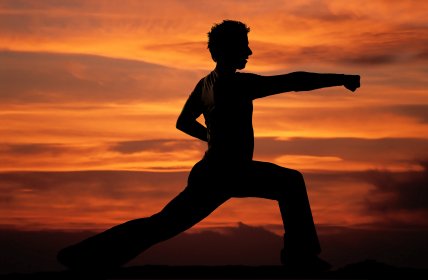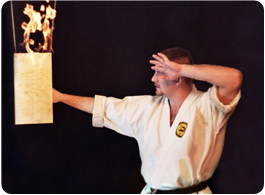LETTER 1. – Kata & bunkai
In response to some of the post on bogus bunkai and some Okinawan instructors and dojo not having bunkai that seem to be anything but block/punch.
I would agree that there are dojo on Okinawa that fall into the above category. Please remember that we are discussing human beings and the frailties and shortcomings are the same whether you live in Okinawa, Japan or the USA. I believe that Goshiki (sp) is right in relating other’s observations to him that their is a lack of bunkai understanding in Okinawa. But there is some very good reasons behind the lack of the focus on bunkai training.
I believe the most important factor was the dissemination of karate to Japan. The entire method of training was changed to cater to the teaching karate as physical exercise in the public schools. The next factor was the rapid development of karate styles in Japan. It is hard to imagine that from 1922 to 1937 there was no less than a dozen different styles developed by Japanese on the mainland. So, in 15 years you had this many people move up to the position of leading their own school. Why there are countless of us in the USA and Okinawa that have been with the same teachers for thirty years and if we started our own group we would be soundly criticized. How did this effect the bunkai of the kata ? They did not stay with the Okinawans long enough to learn and the karate that was taught in the beginning was kihon only. The Japanese had a strong desire to use what they were learning and they developed the jiyu kumite as a supplement for not knowing the bunkai. The sparring matches became their method of measuring their karate skills whereas the Okinawans had only used the measurement of being able to defend themselves and live long lives.
The Okinawans became victim to this same thought process after the war. Why ? Because only a handful of the older teachers were left and many of the teachers who began teaching after the war were trained in school karate where the emphasis was on body and spirit development. The method of training on Okinawa followed the Japanese for many years with the emphasis on bogu jiyu kumite. The training methods were changed or adapted in many dojo to improve the ability to free spar vs. actual combat.
I am not saying that all Okinawan schools followed this way but many of them did. I believe most of all the senior teachers had the knowledge of what karate had been but due to the changing times they designed their instruction to meet the perceived needs of the day.
I have observed over the last nine years in Okinawa a resurgence of traditional Okinawan karate. A symposium was held in August of 1990 after the Uchinanchu demonstrations to establish the direction of Okinawan karate. I was fortunate to attend this symposium and witnessed the senior teachers calling for a return to traditional Okinawan karate and kobudo. Since that time much effort and expense has been expended to but the emphasis on re-establishing Okinawan karate as it should be. I have been to Okinawa 14 times in the last nine years and have seen a dramatic change on the emphasis being placed on training methods.
In the late 60’s when I lived on Okinawa more emphasis was put on kihon, kata and jiyu kumite. One of the reasons was that is what Americans liked and enjoyed. Many of the Okinawan teachers made their livings teaching servicemen. Most of these men were only on Okinawa for 18 months so the training was geared to having them experience the Okinawan karate and enjoy their time on Okinawa. Yes, I know that most of the servicemen who were there on Okinawa during this time will say that they learned more than just kihon, kata and jiyu kumite and perhaps some did but those that will be honest with themselves should answer just as the Japanese should have from what they learned from the Okinawans and that is they did not even hear the word bunkai from the Okinawans. The word bunkai is not even Unchinanguchi. The Okinawans that I trained with used the term ti chi ki, which I was told meant showing what the hand is doing.
I have rambled on enough about all of this so please forgive me. The point is that the Okinawans knew and still know the bunkai of the kata. They were just emphasizing something different.
I have an acquaintenance that I have known for about thirty years. He is an 8th dan now and several years ago I had the opportunity to train in his dojo frequently over a period of a year while on business trips. He would ask me questions concerning bunkai of kata and I would give him answers thinking all along that he was just pulling my leg when he would say he had never seen the explanations of the kata like that. He asked me how did I get this information. I told him that my teacher’s father would show me during our morning classes. After a couple of months had gone by he said he thought that I must be making these applications up. He said they made sense but he knew that if his sensei (different than mine and very highly thought of on Okinawa) knew these applications he would have taught him. Sometime after this he and I went to Okinawa together and he asked his teacher in front of me some kata bunkai questions. His teacher readily gave him similar answers that I had provided even though we are from a different school. He said why haven’t you taught me this before ? The reply was that you never asked me and I thought you were satisfied with what you were getting. I believe the point to this story is that the Okinawans were giving the Japanese and Americans what they thought they wanted. Surely this must have been easy to think because neither the Japanese or Americans ever went back to Okinawa for much training after their initial introduction to Okinawan karate. How many Japanese that created these various schools ever went to Okinawa and trained for any length of time ?
What do most of the students who come into your dojo want ? What are you giving them ? How many times as we as teacher wanted our students to want more and we were willing to give it to them but they demonstrated by their actions that they were satisfied with kick/punch.
I will close for now and hope that I have not dragged this out to much. One thing I did not discuss was the thought put forth by some that there are no blocks in karate bunkai. I would like to discuss this at a later date if anyone has an interest.
Thanks for reading all of this if you did and I apologize if I took to much bandwidth.
Oh, a question for the members who attended the Okinawan Rengokai seminars.
Did you see any bunkai applications of the kata ?
Gumbatte
Dan Smith
E-mail response from Cyberdojo. Mr. Dan Smith is Vice president: International Okinawan Shorin Ryu Seibukan Karate Assn.



i need to know much a bout you, also i need a silabas of JKA.
Isn’t it the duty of karate instructors to past full karate on? Alot of people complain about teachers not being qualitfied in karate. But if there teAcher didn’t pass on full karate to them and then gave them Dan ranks then who is really to blame? If someone wants to learn karate then they should be taught it without hesitation and preconcived notions about what they want. If u want to pass grade school for example, u need to pass your subjects regardless if u have interest in them. Same with karate.
Just a thought. Traditionally Karate was taught Uchi Deshi style. A lot of knowledge is lost when you teach in groups. Also the student must be able to figure out a large part of how the techniques work, be able to ask the right questions at the right time. It takes a long time to get minute details right. Some of the techniques are so normal for them but not common for outsiders. I agree with the article in a sense that sport karate focused on kihon. Kata, bunkai, oyo bunkai, kake, hojo undo and sparring are integrated and should not be considered separate from each other. Taika Oyata explains the use of Kata and bunkai very well.